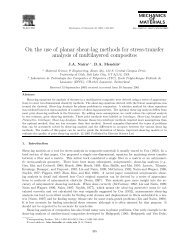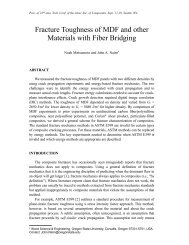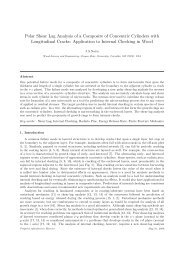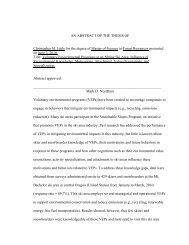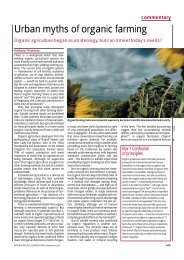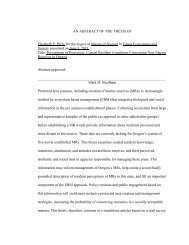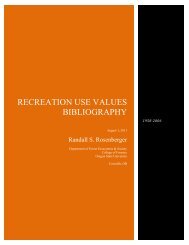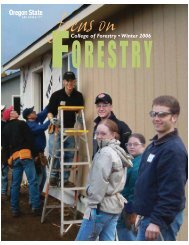College of Forestry - Oregon State University
College of Forestry - Oregon State University
College of Forestry - Oregon State University
Create successful ePaper yourself
Turn your PDF publications into a flip-book with our unique Google optimized e-Paper software.
Features<br />
There’s a Fungus Among Us!<br />
Outsmarting Swiss needle cast in coastal forests<br />
Flying over the <strong>Oregon</strong> Coast Range in the<br />
spring can be frightening, even if you like<br />
flying low in a small plane. It’s the landscape<br />
below that can be distressing—thousands <strong>of</strong><br />
acres <strong>of</strong> Douglas-fir, stripped <strong>of</strong> many <strong>of</strong> their<br />
needles by Swiss needle cast.<br />
“Swiss needle cast is present just about everywhere<br />
without being a problem,” says Dave Shaw, Director <strong>of</strong><br />
the Swiss Needle Cast Cooperative (SNCC). “The fungus<br />
that causes it requires optimal conditions for spores to<br />
germinate and grow, and apparently conditions are really<br />
optimal in the Coast Range.”<br />
SNCC scientists are pursuing four research tracks:<br />
epidemiology, silviculture, soil characteristics, and tree<br />
improvement. The first two are best developed, with Jeff<br />
Stone (Botany and Plant Pathology) taking the lead in<br />
epidemiology and Doug Maguire, Hayes Pr<strong>of</strong>essor <strong>of</strong><br />
Silviculture, heading up the silvicultural efforts.<br />
Every April, aerial survey specialists from the <strong>Oregon</strong><br />
Department <strong>of</strong> <strong>Forestry</strong> and USDA Forest Service fly over<br />
the Coast Range before budbreak to map the range <strong>of</strong> the<br />
disease. Their flights have shown that the severity <strong>of</strong> SNC<br />
ebbs and flows markedly over time and varies within a<br />
geographical zone. Even in a high severity area, there may<br />
be relatively healthy trees or plantations.<br />
Collaborating with other scientists, Stone and Len<br />
Coop (with the OSU Integrated Plant Protection Center)<br />
have been developing a spatially explicit epidemiological<br />
model that takes into account effects <strong>of</strong> topography, elevation,<br />
aspect, and location on local weather and, hence, on<br />
the observed spatial and temporal variation in SNC severity,<br />
says Shaw. Warm winter temperatures and cool moist<br />
springs followed by wet summers are key drivers that increase<br />
SNC. Topography,<br />
convergence<br />
and divergence <strong>of</strong><br />
incoming weather<br />
systems, winds,<br />
and fog and drizzle<br />
are also important<br />
factors.<br />
Maguire has been<br />
working with SNCC since<br />
it was organized in 1997.<br />
His silvicultural studies over<br />
the years have included the<br />
impact <strong>of</strong> SNC on growth<br />
and yield and, conversely,<br />
the effect <strong>of</strong> silvicultural<br />
activities on SNC severity.<br />
The permanent plots that he<br />
established nearly a decade<br />
ago allow diverse and thorough measurements<br />
to be taken over time, and his data have provided<br />
a robust quantitative understanding <strong>of</strong> the<br />
effects <strong>of</strong> SNC on growth and yield <strong>of</strong> Douglasfir<br />
and <strong>of</strong> the effects <strong>of</strong> silvicultural treatments<br />
on pathogenicity <strong>of</strong> SNC. He has found, for<br />
example, that commercial thinning can be carried<br />
out on SNC-affected plots without negatively<br />
affecting the stands, so structure-based<br />
management on state lands can be continued<br />
without making the disease worse.<br />
Maguire has been collaborating with<br />
David Hann, Pr<strong>of</strong>essor <strong>of</strong> Forest Resources,<br />
and Sean Garber, research assistant in Forest<br />
Science, to develop a new module for the<br />
ORGANON growth-and-yield model to estimate<br />
growth impacts <strong>of</strong> SNC. “This is very<br />
important work that really helps landowners<br />
determine growth, allowable cut, and<br />
harvest schedules,” says Shaw.<br />
In the long term, Shaw, Maguire,<br />
Stone, and their collaborators hope to<br />
meld the epidemiological and silvicultural<br />
models. Managers would then be able<br />
to predict SNC severity at the plantation<br />
level based on historical weather<br />
regimes or future climate scenarios.<br />
More information about SNCC<br />
is available at http://www.c<strong>of</strong>.orst.<br />
edu/coops/sncc/<br />
13





